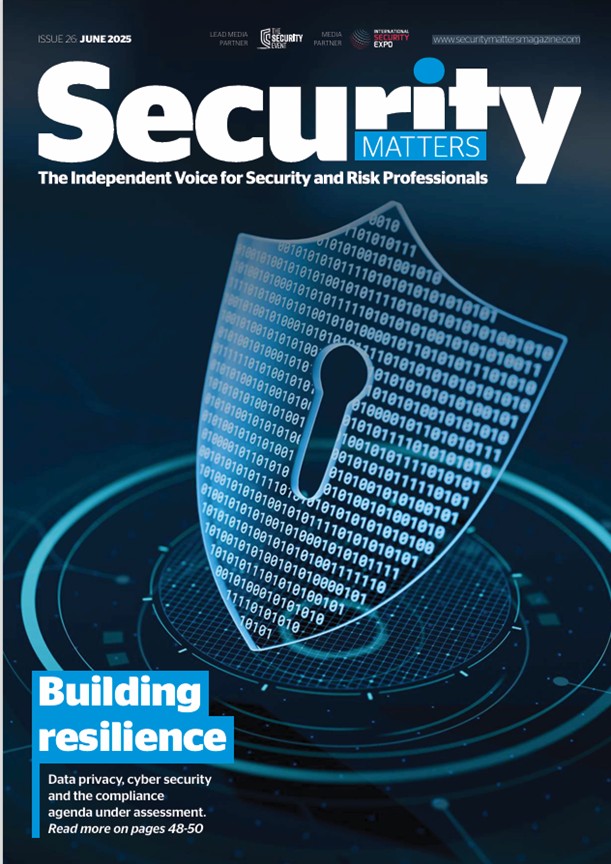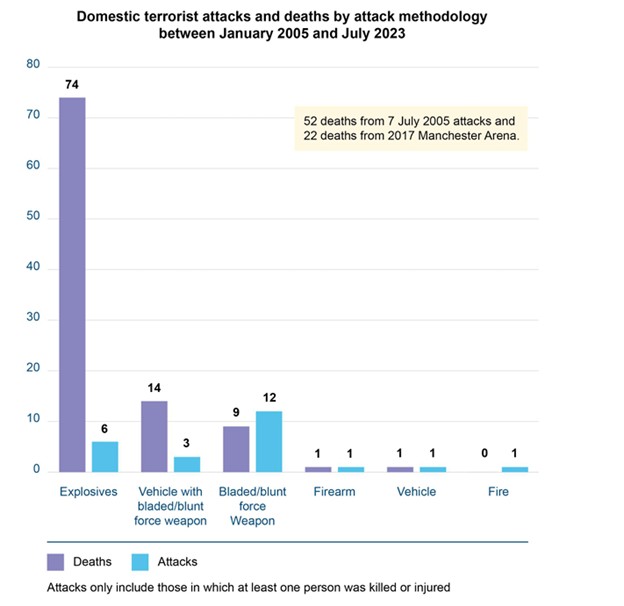The new standard launched by Loss Prevention Certification Board (LPCB) received a warm welcome from built environment security professionals. It comes at a time when knife crime figures in the UK soar, the volume of protest events increases, and hate related tensions continue to drain police resources. LPS 1673 provides a much-needed response to increasing levels of violent crime.


The new standard sets out testing criteria for protection against violent attacks using bladed and blunt impact instruments.
Instruments that the LPS 1673 tests against include knives and other widely available tools that are known to pose a real threat to community safety. Criminal incidents involving the use of bladed weapons hit the headlines almost every day. A 15-year-old Harvey Willgoose is one of the latest victims of a fatal stabbing at a South Yorkshire Catholic high school. On the same day, journalists were covering the story of a 14- year- old girl who attempted to murder her teachers at a school in south Wales. The last year’s mass stabbing incident in Stockport, dishonorably exploited by right wing influencers to push xenophobic agenda, triggered a wave of riots across the UK.
Solutions to reduce the harm caused by violence are desperately needed. There are hopes for the impact of the Terrorism (Protection of Premises) Act 2025 to spread across a wider range of violent crime themes. The new legislation, also known as Martyn’s Law, will require those responsible for certain premises and events to take steps to mitigate the impact of a terrorist attack and reduce harm. Knowing the level of protection available within the premises is fundamental for any security strategy, policy or procedure to be viable.
The new standard strikes the right balance between the compliance requirements in security and the built environment project constraints. By launching the LPS 1673, LPCB once again demonstrated a thorough understanding of security risk management as well as the property, construction and infrastructure development needs.
LPCBs familiarity with the built environment can be attributed to its affiliation with the world-renowned Building Research Establishment (BRE) BRE Global Ltd. The sound judgment on security related matters may be accredited to LPCBs close collaboration with the industry stakeholders such as the National Protective Security Authority (NPSA) and the National Counter Terrorism Security Office (NaCTSO).
Several market leading security consultants also assisted with preparation and review of the standard. Those include ARUP, Buro Happold, CPTED-UK, Optimal Risk and others who between them deliver security strategies for any type, size and shape of property imaginable on a daily basis.
The LPS 1673 standard is a testament to the value of multidisciplinary cross-sector collaboration.
The belief that high prices equate to effectiveness prevails in many industries, security being one of them. Meanwhile, the barriers to incorporating protective security into the development processes are often discussed by security professionals. Whilst the lack of awareness and the lack of legal regulations are often mentioned, the cost always comes out on top.
Is it possible to reduce the cost of protective security without compromising the quality of the design? Most independent security consultants would argue that effective risk management can reduce the overall costs of a project.
Richard Stones OBE, CPTED-UK Director and the Design Council Expert explains:
“Understanding the security needs from the project stakeholder’s perspective is fundament for risk management. A high-quality design must be aligned with their objectives and address the specific challenges that the project is likely to encounter. For example, the risk of shrinkage in retail may be acceptable but the impact of violence against staff on business is too high to ignore. It can lead to reputational damage, higher staff turnover, low morale, increased costs of training and maintaining a reliable workforce. People should always be in the focus of any protective security strategy, that’s why the LPS 1673 is so appropriate across a wide range of property uses.”.
Compliance with legal and regulatory requirements is a key objective for any built environment project. Whilst planning policies leave a generous amount of room for interpretation, planning conditions are usually more specific.
Secured by Design (SbD) remains the most common security accreditation scheme referred to by Planning in the UK. Sometimes the SbD certification is specifically required. More often the planning conditions ask for secured by design principles to be followed. Referring to the principles instead of certification may be purely pragmatic as in many areas of the UK the Police resources dedicated to Designing out Crime are being reduced.
The expertise in built environment security may be shifting towards becoming a domain of independent security consultants, like in many other advanced countries across the world. We now see a gradual shift towards embracing the risk-based approach to security by Planning Authorities in the UK. The evolving landscape is reflected by planning conditions such as:
“Prior to commencement of development details of measures to demonstrate how Secured by Design requirements or those of a similar security accreditation scheme, will be adequately achieved within the development shall be submitted…”,
or
“No development of any building shall take place above slab level until a site wide crime prevention strategy has been submitted to and approved in writing by the local planning authority.”
The Security Overlay to RIBA Plan of Work advocates a risk-based approach to security risk management which is aligned with the globally recognised ISO 31000. The Overlay is still relatively new, and security professionals should use it every time they engage with their counterparts in urban planning and design. It captures the security risk management process using terms that planners, architects and property developers can relate to.
The National Risk Register 2025 is more technical when it comes to the risk management methodology. Unlike security professionals, the property developers don’t have to go to that level of detail. The Register clearly and concisely explains its risk assessment methodology. It uses the likelihood vs impact matrix as the most appropriate visualization tool. A similar process is used on a smaller scale by security consultants to assess the risks applicable to the premises they work on.
The national, local and sector specific crime trends allow us to assess the risk profile for individual types of property and infrastructure- retail, healthcare, education, storage & distribution, research & development, leisure and others.
In the latest National Risk Register the average impact score for risks grouped under the Terrorist attacks in publicly accessible locations category is 3 (moderate) and the average likelihood score is 5 (>25%). The Register explores explosive devices and marauding attacks scenarios. Restricting access to explosives precursor chemicals and improving detection capabilities at the government level reduces the likelihood of the explosive devices’ deployment. In the UK terrorists have long adopted more easily accessible attack methods, such as knives that are easy to obtain, to conceal and to dispose of.
Built environment plays a crucial role in reducing the vulnerability to a marauding terrorist attack. The government provides support for venues, public places and specific sectors. It includes free advice, guidance and training through ProtectUK. The new Terrorism Bill will also provide much-needed support for those in facility management of the venues.
Risk associated with the use of bladed and blunt force weapons in terrorist attacks in the UK is explored in the CONTEST strategy. It investigates and helps to visualise the methodology of domestic terrorist attacks and deaths by attack methodology between January 2005 and July 2023 .

Physical measures to discourage attackers in an MTA scenario provide many additional advantages for safety and security. The LPS 1673 development team used evidence from multiple MTA case studies. The standard is compatible with the NPSA guidance on physical barriers, lockdown procedures and the counter terrorism Run Hide Tell model of response.
Terrorism is not the only type of crime with a high impact on the communities. The alarming knife crime statistics published in January 2025 are hardly surprising. According to the Ben Kinsella Trust, there has been an 80 per cent increase in police-recorded offences involving a knife or sharp instrument in the past 10 years (up to June 2024) across the country.
The recent publication of knife crime statistics in England and Wales coincided with the release of the “Our Knife Crime Crisis” documentary on BBC. The personal dimension provided by the east London born actor Idris Elba adds gravitas to the public perception of the issue.
Knife crime is often associated with drugs and gang activity in the UK, with the “County Lines” featuring as a priority crime theme in many areas. Increasingly common in the UK mental health issues need to be considered as a threat to security in any location and any circumstances, especially since they frequently demonstrate themselves in erratic, unpredictable acts of violence.

Given the global complexity of political and social issues affecting many communities and locations, there is a strong possibility for demonstrations and protests to impact the built environment. Areas with a dense population of Government buildings and financial institutions are especially susceptible to protests and disorder. The ability to lock down the buildings is therefore considered necessary to protect the occupants.
Ability to identify the threats and assess the risk is essential for security professionals to maintain credibility. Slow response to the evolving threat landscape can make property developers question rationale behind the security investment. Attempts to endorse solutions that are not fit-for-purpose can undermine credibility of the individual and the wider community of independent security consultants.
Whilst LPS 1175 remains an appropriate standard for many premises, the SR2 level of protection is often specified as ‘default’ with little or no regard given to the risk profile or other layers of protective security deployed by the organization.
There is a fundamental difference between security requirements of the physical and the human assets: the latter do respond to the threatening circumstances. Our survival mechanisms activate in response to a threat, our nervous system runs into riots, and we enter the fight-or-flight mode. Security strategy should factor in the human’s natural ability to react to danger.
That said, we know as much about ourselves as we have been tested. Therefore, security practitioners should always seek or create opportunities to test the response to a violent attack.
In majority of publicly accessible locations response to a violent incident is available from what Crime Prevention through Environmental Design (CPTED) calls a ‘capable guardian’ or ‘place manager.’ Schools, community centers, places of worship, hospitals, high streets all have people dedicated to operational management of the place and safeguarding. Policies and procedures to protect people should aim to utilise the full menu of measures available. They should always be informed by technical specifications of the building components but other risk mitigating factors should also be considered for the response to be proportionate.
LPS 1175 remains an appropriate standard for many built environment and infrastructure assets. It has now been widely adopted internationally, including assets classed as Critical National Infrastructure. The new LPS 1673 standard provides the industry with an alternative which is particularly relevant for scenarios where the risk profile indicates that people should be the security strategy’s prime consideration.
Publication of the new standard LPS 1673 certainly provoked some thought on the character of assets that require protection and the behavioral patterns of individuals that pose a threat. LPS 1673 is without a doubt a remarkable achievement of the industry and a ‘must read’ for those who wish to maintain professional competence in the built environment security.
The Security Matters June 2025 is available HERE
